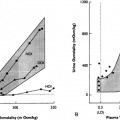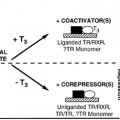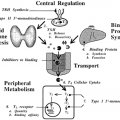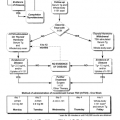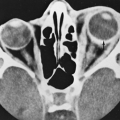INFLUENCE OF HORMONES AND DRUGS ON MELATONIN SECRETION
Part of “CHAPTER 10 – PINEAL GLAND“
Most of what is known about the interactions of the postganglionic neurotransmitter norepinephrine with the pinealocyte comes from observations in animals, although the relationships probably are similar in humans. Norepinephrine is released into the synaptic cleft, primarily during the daily dark period, after which it acts primarily on β-adrenergic receptors on the pinealocyte membrane, where it stimulates cyclic adenosine monophosphate production and, eventually, N-acetyltrans-ferase activity and melatonin synthesis (see Fig. 10-2).4 Alpha receptors on the pinealocyte membrane also may be involved in mediating the nocturnal rise in melatonin. In humans, the peripheral infusion of isoproterenol, a β-receptor agonist, does not increase blood levels of melatonin as readily as it does in some animals. In addition, orciprenaline and L-dopa are ineffective in altering circulating melatonin in humans. The inability of isoproterenol to stimulate human pineal melatonin production may relate to the relative insensitivity of the pinealocyte β-receptors to the agonist throughout most of the day; animal studies have shown that either the number of receptors or their affinity for the ligand is greatly increased at night.5 Circulating norepinephrine may be relatively ineffective in promoting pineal melatonin production because the sympathetic nerve endings in the pineal gland have an active uptake mechanism for the catecholamine, thereby protecting the pinealocytes from circulating norepinephrine.
Stay updated, free articles. Join our Telegram channel

Full access? Get Clinical Tree


